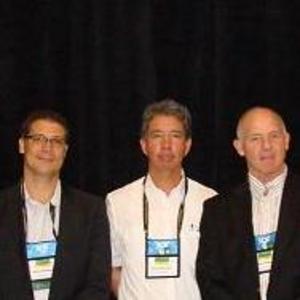Experts address feedstock development at Calif. biodiesel event

Photo: Ron Kotrba, Biodiesel Magazine
January 22, 2014
BY Ron Kotrba
To grow a successful, sustainable biodiesel industry in California, feedstock development is essential. The Golden State’s biodiesel industry gathered in San Diego this week for its annual event—the California Biodiesel and Renewable Diesel Conference organized by the California Biodiesel Alliance—where issues, opportunities and progress in state feedstock development were discussed by a panel of experts, titled, “Feedstock Development in California.”
Stephen Kaffka, director of the California Biomass Collaborative at UC Davis told the audience that California has 85 canola and 61 camelina varieties. Orchards, big business in California, have significant amounts of “unused” growing land between tree rows, which Kaffka said presents an opportunity to grow oilseeds for biodiesel feedstock.
But, he said, “You can’t understand the feedstock potential without understanding the soil differences.”
Gary Banuelos, a plant/soil scientist with USDA’s Agricultural Research Service’s Water Management Research Unit, also an adjunct professor at CSU Fresno, said much of California’s soil is high in salt, boron and selenium, which can cause stress to crops and makes strategic rotation between crops such as sunflower, safflower, canola and mustard an important management practice. Kaffka said crop rotation practices must be complementary and not competitive, and reasons for complementary rotation exist that are not always obvious.
Advertisement
Banuelos said 80,000 acres of prime farm land in the state had to be pulled out of production due to the selenium problem. Other parts of the world, however, have deficiencies in the micronutrient, so selenium-enriched seed meal is an opportunity for California oilseed growers. But, as Banuelos said, “it all begins with water,” and California is in the midst of major, extended drought.
Recognized algae expert Stephen Mayfield, director of the San Diego Center for Algae Biotechnology at UC San Diego and co-founder of Sapphire Energy, said even though the algae industry has made notable progress, large-scale production of algae oil for biodiesel is still held back by the cost issue.
“We’re starting to understand pathogen-host interactions,” Mayfield said. Largely through his bioprospecting work, Mayfield has seen a doubling of algae growth yields since 2009, moving from 20 to 40 tons an acre with 45 percent lipid content.
According to Mayfield, crop rotation is important for algae too. Sapphire Energy grows cyanobacteria at its Las Cruces, N.M., site in the summer months and in the spring and fall it switches back to green algae.
San Diego-based biotechnology firm SG Biofuels weighed in on jatropha developments. Andre Basbaum, SG Biofuels’ director of global corporate development, said the company has raised $35 million in the past seven years. With that funding, SG Biofuels has developed 2,000 jatropha hybrid varieties tested in India, Brazil and Guatemala. These varieties produce 400 to 900 percent higher yields than “generic” jatropha, Basbaum said.
Advertisement
“The market cares for price, volume and competition,” he said. “I wish people understood how much money and time it takes to build sustainable fuels. We need more support from industry and government.”
Alan Weber, founding partner of Marc-IV Consulting, said there needs to be crop protection and risk mitigation to successfully develop new biodiesel feedstocks. Without crop insurance, getting a loan to fund a farming operation is next to impossible, he said.
To foster growth in new or emerging feedstock, Banuelos said it is important to partner with a grower who has a good reputation.
Kaffka said policy stability is key to successful feedstock development.
“Drop-in fuels is a siren song,” added Mayfield. “There are plenty of intermediate solutions we can use right now, but what we are missing is political leadership with the ‘cojones’ to make a 10-year political commitment.”
Related Stories
SAF Magazine and the Commercial Aviation Alternative Fuels Initiative announced the preliminary agenda for the North American SAF Conference and Expo, being held Sept. 22-24 at the Minneapolis Convention Center in Minneapolis, Minnesota.
Scientists at ORNL have developed a first-ever method of detecting ribonucleic acid, or RNA, inside plant cells using a technique that results in a visible fluorescent signal. The technology could help develop hardier bioenergy and food crops.
The 2025 International Fuel Ethanol Workshop & Expo, held in Omaha, Nebraska, concluded with record-breaking participation and industry engagement, reinforcing its role as the largest and most influential gathering in the global ethanol sector.
TotalEnergies and Quatra, the European market leader in the collection and recycling of used cooking oil, have signed a 15-year agreement beginning in 2026, for the supply of 60,000 tons a year of European used cooking oil.
The USDA maintained its forecast for 2025-’26 soybean oil use in biofuel production in its latest World Agricultural Supply and Demand Estimates report, released June 12. The estimate for 2024-’25 soybean use in biofuel production was revised down.
Upcoming Events










